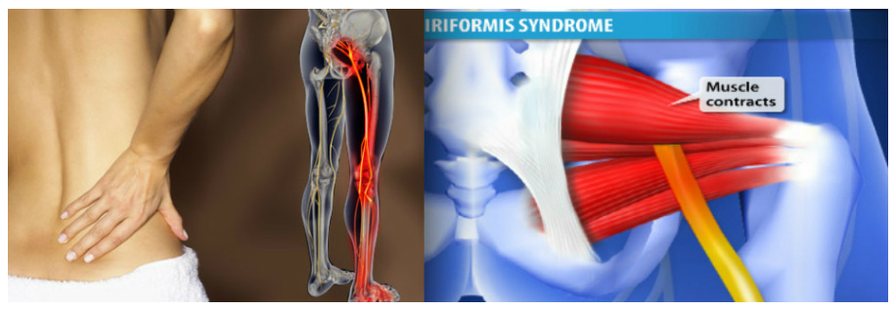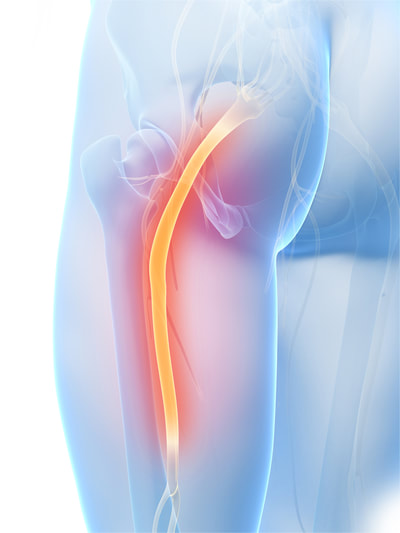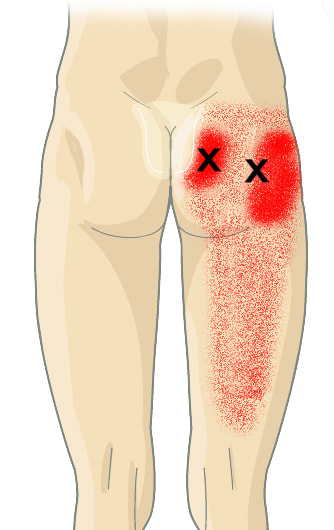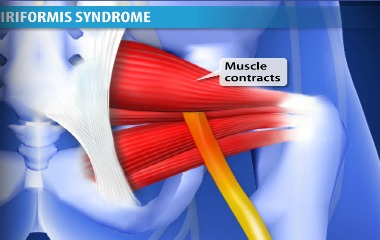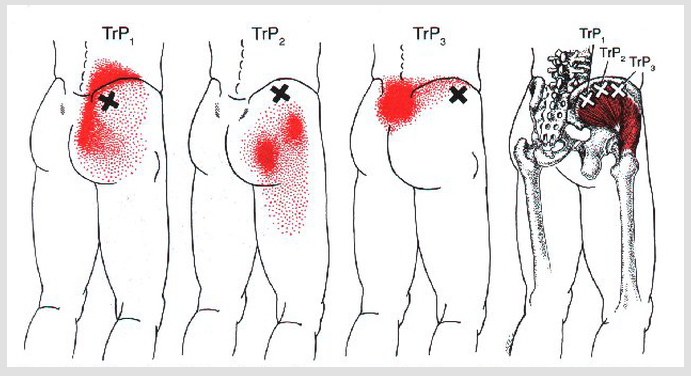Lower Back Pain [Sciatica]

Sciatica & Lower Back Pain -------- [Source - betterhealth.vic.gov.au/health]
"Sciatica is a pain in the butt :) and leg, caused by pressure on nerves in the lower back. The pressure can be triggered by slipped vertebral discs, pinched nerves or some forms of arthritis. Sciatica is nerve pain arising from the sciatic nerve, which can be produced by pressure on the nerve, where it passes through the buttock. Sciatica can be brought on by sitting on a hard seat. The sciatic nerve is a large nerve that is formed from nerve roots that originate from the spinal cord. These nerve roots pass out between the disc spaces and join up to form the sciatic nerve. It passes from the spine into the buttock, then into the back of the thigh and leg. The sciatic nerve controls sensation and function to the leg and foot. In sciatica, prolapsed or 'slipped' discs tend to bulge and press on the intervertebral nerve(s). This pressure irritates the nerve, causing referred pain. Treatment options include rest, painkillers, epidural injections and surgery."
EDITORS NOTE – surgery and epidurals are not usually required, [read what Professor Harris, a lecturer/surgeon from The University of NSW has to say on unnecessary surgical intervention] but are often performed due to the belief that the pain is consistent with Osteoarthritis (wear and tear) of the spine. However, that is not necessarily so: remember that virtually everyone over thirty years old has Osteoarthritis. Doctors are on record, stating that as many as 30% of operations are may not be necessary - CLICK HERE.
Given that most doctors are reluctant to criticise other doctors, it is extremely likely that the number of unnecessary operations is in excess of the aforementioned 30%. Based on my clinical experience, skilfully applied remedial therapy is an effective means to relieve sciatica pain. Even when an MRI clearly shows arthritic degenerative changes, remedial massage, sometimes in conjunction with a personalised program of stretching and strengthening, will almost always create significant improvement.
If you look at the images below of the Piriformis muscle in the butt/Gluteus muscles, it is easy to see how the sciatic nerve can be compressed, thus causing the same symptoms as degeneration of the lumbar spine. It is obvious that muscle shortening/spasm of the Piriformis [centre image of active Trigger Point referring pain down leg] will compress the nerve. Fortunately, this particular condition is easily rectified by a competent therapist.
Sciatica & Lower Back Pain -------- [Source - betterhealth.vic.gov.au/health]
"Sciatica is a pain in the butt :) and leg, caused by pressure on nerves in the lower back. The pressure can be triggered by slipped vertebral discs, pinched nerves or some forms of arthritis. Sciatica is nerve pain arising from the sciatic nerve, which can be produced by pressure on the nerve, where it passes through the buttock. Sciatica can be brought on by sitting on a hard seat. The sciatic nerve is a large nerve that is formed from nerve roots that originate from the spinal cord. These nerve roots pass out between the disc spaces and join up to form the sciatic nerve. It passes from the spine into the buttock, then into the back of the thigh and leg. The sciatic nerve controls sensation and function to the leg and foot. In sciatica, prolapsed or 'slipped' discs tend to bulge and press on the intervertebral nerve(s). This pressure irritates the nerve, causing referred pain. Treatment options include rest, painkillers, epidural injections and surgery."
EDITORS NOTE – surgery and epidurals are not usually required, [read what Professor Harris, a lecturer/surgeon from The University of NSW has to say on unnecessary surgical intervention] but are often performed due to the belief that the pain is consistent with Osteoarthritis (wear and tear) of the spine. However, that is not necessarily so: remember that virtually everyone over thirty years old has Osteoarthritis. Doctors are on record, stating that as many as 30% of operations are may not be necessary - CLICK HERE.
Given that most doctors are reluctant to criticise other doctors, it is extremely likely that the number of unnecessary operations is in excess of the aforementioned 30%. Based on my clinical experience, skilfully applied remedial therapy is an effective means to relieve sciatica pain. Even when an MRI clearly shows arthritic degenerative changes, remedial massage, sometimes in conjunction with a personalised program of stretching and strengthening, will almost always create significant improvement.
If you look at the images below of the Piriformis muscle in the butt/Gluteus muscles, it is easy to see how the sciatic nerve can be compressed, thus causing the same symptoms as degeneration of the lumbar spine. It is obvious that muscle shortening/spasm of the Piriformis [centre image of active Trigger Point referring pain down leg] will compress the nerve. Fortunately, this particular condition is easily rectified by a competent therapist.
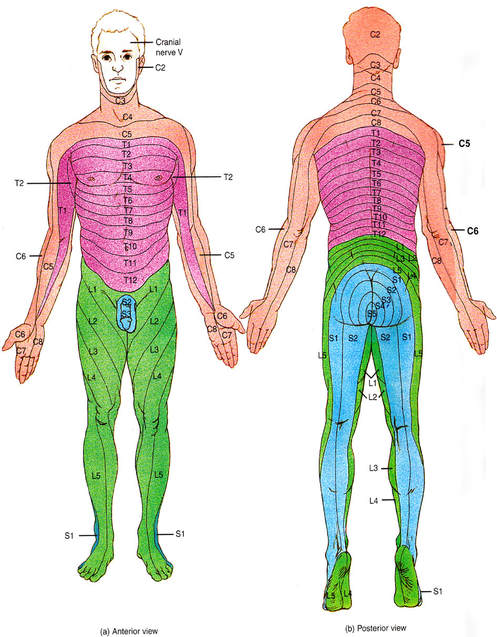
It has been stated by Murphy et al., 2009 that the pattern of referred pain from a particular nerve is not necessarily confined to its dermatome.
EDITOR: Umm, I have my doubts about that statement. I suggest that the truth in this case may well be subject to the doctors expectation that the symptoms of lower back pain and sciatica originates from the spine. Such an expectation has its origin in the burden of proof placed on western medicine. Said proof is necessary to form a diagnosis that then justifies the administration of drugs, epidurals and surgery.
An acceptable ‘proof’ is offered by the degree of osteoarthritis in the Lumbar spine. However as stated below, the extent of osteoarthritis of the spinal structure does not determine the amount of pain, if any that is experienced by the patient. Furthermore, many patients present to the therapist with a pattern of referred pain that runs along the dermatomes of S1 - S2 - S3 - S4.
If you look to the left you will see that those particular nerves are not located in the Lumbar spine. Yet the decision to operate or prescribe other invasive practices is based on findings (osteoarthritis) from the lumbar spine. Explaining the rational behind the previous statement made by Murphy et al 2009.
Indeed, the majority of referred pain (sciatica) that runs down the legs and along the path of the dermatomes (NOTE: it is more correct to say the pain refers along the path of the of sclerotomes - according to Dommerholt, et al 2013) originates from these nerves. How would spinal fusion or the shaving of a disc in the spine have any effect on the nerves between S1 - S5 ? Not surprisingly such intervention is seldom successful, necessitating secondary surgery , which is equally unsuccessful.
CONCLUSION:
Appropriate remedial therapy is often completely successful in alleviating all the symptoms of pain and weakness in the same classification of patients, provided the remedial therapy was implemented prior to surgery. The treatment certainly involves therapy to the Quadratus Lumborum, and patient self-help stretches as demonstrated HERE. However, Trigger Point Therapy to the Quadratus Lumborum rarely reproduces the sciatic pain down the legs. Conversely, deep pressure in the gluteus muscles will almost always reproduce the symptoms of sciatica distally - and upon treatment allow prompt return to work.
EDITOR: Umm, I have my doubts about that statement. I suggest that the truth in this case may well be subject to the doctors expectation that the symptoms of lower back pain and sciatica originates from the spine. Such an expectation has its origin in the burden of proof placed on western medicine. Said proof is necessary to form a diagnosis that then justifies the administration of drugs, epidurals and surgery.
An acceptable ‘proof’ is offered by the degree of osteoarthritis in the Lumbar spine. However as stated below, the extent of osteoarthritis of the spinal structure does not determine the amount of pain, if any that is experienced by the patient. Furthermore, many patients present to the therapist with a pattern of referred pain that runs along the dermatomes of S1 - S2 - S3 - S4.
If you look to the left you will see that those particular nerves are not located in the Lumbar spine. Yet the decision to operate or prescribe other invasive practices is based on findings (osteoarthritis) from the lumbar spine. Explaining the rational behind the previous statement made by Murphy et al 2009.
Indeed, the majority of referred pain (sciatica) that runs down the legs and along the path of the dermatomes (NOTE: it is more correct to say the pain refers along the path of the of sclerotomes - according to Dommerholt, et al 2013) originates from these nerves. How would spinal fusion or the shaving of a disc in the spine have any effect on the nerves between S1 - S5 ? Not surprisingly such intervention is seldom successful, necessitating secondary surgery , which is equally unsuccessful.
CONCLUSION:
Appropriate remedial therapy is often completely successful in alleviating all the symptoms of pain and weakness in the same classification of patients, provided the remedial therapy was implemented prior to surgery. The treatment certainly involves therapy to the Quadratus Lumborum, and patient self-help stretches as demonstrated HERE. However, Trigger Point Therapy to the Quadratus Lumborum rarely reproduces the sciatic pain down the legs. Conversely, deep pressure in the gluteus muscles will almost always reproduce the symptoms of sciatica distally - and upon treatment allow prompt return to work.
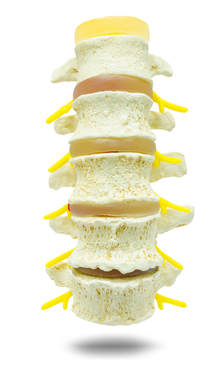
Osteoarthritis & its implications
www.mayoclinic.org - states that Osteoarthritis is the most common form of arthritis, affecting millions of people worldwide. It occurs when the protective cartilage on the ends of your bones wears down over time. Although osteoarthritis can damage any joint in your body, the disorder most commonly affects joints in your hands, knees, hips and spine. Osteoarthritis often gradually worsens, and no cure exists. But staying active, maintaining a healthy weight and other treatments may slow progression of the disease and help improve pain and joint function.
Well that sounds about right - However, osteoarthritis does not equate to pain. A worn vertebral disc of the spine, in itself does not cause pain. Read the following extract from Orthopaedic medicine online to glean an idea as to how widespread, how prevalent osteoarthritis is in the general population. The figure to the left illustrates the wear and tear of Osteoarthritis. However, unless the narrowing of the disc causes compression on the spinal nerve, there will be little or no pain.
"Degenerative changes in the intervertebral discs are so common that they can be regarded as normal physiological processes. Degeneration of the lumbar discs starts very early in life, with clear microscopic signs of degeneration have been demonstrated in a 4-year-old. Several reports of prolapsed discs in children and adolescents show that major disc degeneration appears at or before puberty, and it has been maintained that after the age of 30 years there are no lumbar discs which do not show some degenerative changes. There seems to be no way to escape this degeneration because it affects all, whatever their weight, physical build or athleticism......" © Copyright 2013 Elsevier, Ltd. All rights reserved. MORE INFORMATION & AND MORE INFORMATION
The aforementioned statement is not a surprise to clinical therapists, where people of all ages, and all walks of life report back, neck and joint pain. Ok, what is the cause of pain then, if not the wear and tear that is first mentioned by your doctor after the obligatory X-Ray? Certainly X-Rays, Ct-Scans and MRI's can show the cause of pain (particularly MRI's), although they generally do not!
No....... the cause of pain is neuromuscular.
A tight muscle causes compression on nearby nerves and tissues, while inhibiting blood flow through the arterioles and venules, causing damage within the muscle itself, which in turn attracts inflammatory proteins to the site of damaged muscle cells. In the event of chronic inflammation (which is the usual reason that people seek help) there is a progressive shift in the type of cells present at the site of inflammation, causing simultaneous destruction and healing of the muscle tissue due to the inflammatory process. In cases where the compression is sufficient to inhibit nerve conduction, the symptoms move from soreness and tightness to include neurological symptoms, such as numbness, tingling and lack of strength - I have demonstrated this in my publication on Carpal Tunnel Syndrome.
A remediating solution is required!
While skillfully applied remedial massage is usually successful in treating this condition, this site endeavours to present you with a series of self-help exercises that will assist you in achieving pain free movement. That is, after you have been to Maleny Remedial Therapies to correct any muscle/structural imbalances, and get relief from pain :)
Trigger Point Therapy
The X's below illustrate the site of the TP's (Trigger Points) in the Piriformis and their referral patterns. Incidentally, Trigger Points are discrete, focal, hyperirritable spots located in a taut band of skeletal muscle. They produce pain locally and in a referred pattern and often accompany chronic musculoskeletal disorders.
www.mayoclinic.org - states that Osteoarthritis is the most common form of arthritis, affecting millions of people worldwide. It occurs when the protective cartilage on the ends of your bones wears down over time. Although osteoarthritis can damage any joint in your body, the disorder most commonly affects joints in your hands, knees, hips and spine. Osteoarthritis often gradually worsens, and no cure exists. But staying active, maintaining a healthy weight and other treatments may slow progression of the disease and help improve pain and joint function.
Well that sounds about right - However, osteoarthritis does not equate to pain. A worn vertebral disc of the spine, in itself does not cause pain. Read the following extract from Orthopaedic medicine online to glean an idea as to how widespread, how prevalent osteoarthritis is in the general population. The figure to the left illustrates the wear and tear of Osteoarthritis. However, unless the narrowing of the disc causes compression on the spinal nerve, there will be little or no pain.
"Degenerative changes in the intervertebral discs are so common that they can be regarded as normal physiological processes. Degeneration of the lumbar discs starts very early in life, with clear microscopic signs of degeneration have been demonstrated in a 4-year-old. Several reports of prolapsed discs in children and adolescents show that major disc degeneration appears at or before puberty, and it has been maintained that after the age of 30 years there are no lumbar discs which do not show some degenerative changes. There seems to be no way to escape this degeneration because it affects all, whatever their weight, physical build or athleticism......" © Copyright 2013 Elsevier, Ltd. All rights reserved. MORE INFORMATION & AND MORE INFORMATION
The aforementioned statement is not a surprise to clinical therapists, where people of all ages, and all walks of life report back, neck and joint pain. Ok, what is the cause of pain then, if not the wear and tear that is first mentioned by your doctor after the obligatory X-Ray? Certainly X-Rays, Ct-Scans and MRI's can show the cause of pain (particularly MRI's), although they generally do not!
No....... the cause of pain is neuromuscular.
A tight muscle causes compression on nearby nerves and tissues, while inhibiting blood flow through the arterioles and venules, causing damage within the muscle itself, which in turn attracts inflammatory proteins to the site of damaged muscle cells. In the event of chronic inflammation (which is the usual reason that people seek help) there is a progressive shift in the type of cells present at the site of inflammation, causing simultaneous destruction and healing of the muscle tissue due to the inflammatory process. In cases where the compression is sufficient to inhibit nerve conduction, the symptoms move from soreness and tightness to include neurological symptoms, such as numbness, tingling and lack of strength - I have demonstrated this in my publication on Carpal Tunnel Syndrome.
A remediating solution is required!
While skillfully applied remedial massage is usually successful in treating this condition, this site endeavours to present you with a series of self-help exercises that will assist you in achieving pain free movement. That is, after you have been to Maleny Remedial Therapies to correct any muscle/structural imbalances, and get relief from pain :)
Trigger Point Therapy
The X's below illustrate the site of the TP's (Trigger Points) in the Piriformis and their referral patterns. Incidentally, Trigger Points are discrete, focal, hyperirritable spots located in a taut band of skeletal muscle. They produce pain locally and in a referred pattern and often accompany chronic musculoskeletal disorders.
The TP's (Trigger Points) above mark the sites of the dysfunction in the Glutes and their referral patterns, bearing in mind that the referral patterns can extend as far as the toes. There are additional TP's along the lateral sides of the Sacrum and on the top/dorsal surface of the sacrum as well. However, some these particular points are not well recorded in the literature.
It is unfortunate that when diagnosing lower back pain, most Medical Practitioners attempt to prove that the pain originates from the Lumbar spine. To that end, X Rays, Cat Scans and MRI's are often implemented. However, all that is achieved by such means is a reminded that as we age, we are subject to Osteoarthritis. Although, said arthritis is generally NOT the cause of the pain. As previously stated the pain generally comes from various TPs, but since they don't show up on the aforementioned tests, many Health Practitioners deem them not to exist - to the detriment of your health!
For additional help in overcoming lower back pain - click here to go to stretches!
It is unfortunate that when diagnosing lower back pain, most Medical Practitioners attempt to prove that the pain originates from the Lumbar spine. To that end, X Rays, Cat Scans and MRI's are often implemented. However, all that is achieved by such means is a reminded that as we age, we are subject to Osteoarthritis. Although, said arthritis is generally NOT the cause of the pain. As previously stated the pain generally comes from various TPs, but since they don't show up on the aforementioned tests, many Health Practitioners deem them not to exist - to the detriment of your health!
For additional help in overcoming lower back pain - click here to go to stretches!
